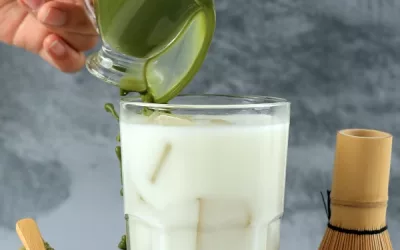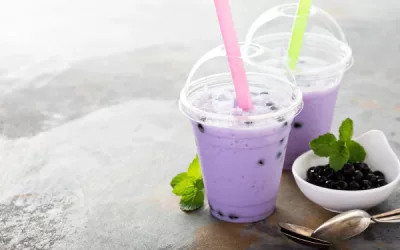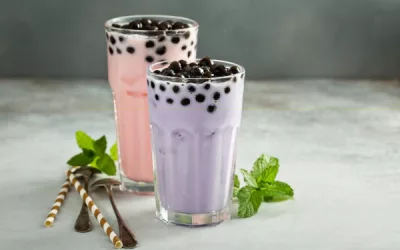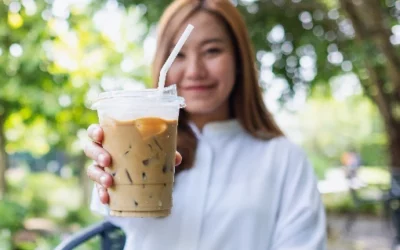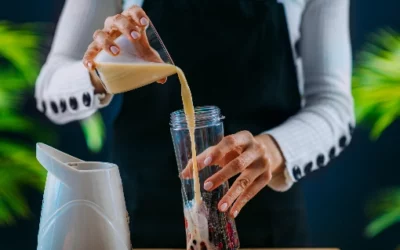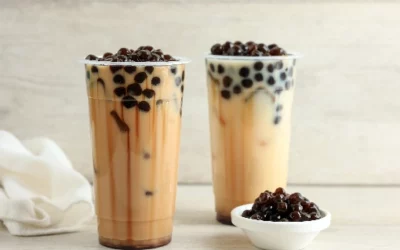I still remember the first time I tasted bubble tea; the chewy tapioca pearls danced in my mouth while the sweet, creamy tea exploded with flavour. It was love at first sip! If you share that excitement, you’re in the right place. In this article, we’ll dive into the most popular flavours of bubble tea, uncovering both the classics and the innovative creations that have taken the world by storm. Whether you’re a fan of milk tea or curious about yogurt tea, this guide will help you explore your options and understand the cultural significance behind each sip. Let’s embark on this delicious journey together!
Table of Content
- What are the classic flavours of bubble tea?
- What are the most popular fruit-based bubble tea flavors?
- How to use this table
- What is the unique charm of fruit-based bubble tea?
- How does the cultural context influence flavor popularity?
- What are the unique and innovative flavors of bubble tea?
- Yogurt tea: tangy twist on tradition
- Cheese tea: the quirky contender
- Popping boba: balls of surprise
- Herbal tea: wellness in a cup
- Brown sugar milk tea: caramel dreams
- How do regional preferences influence bubble tea flavors?
- What are the most popular flavors in Asia?
- How do Western tastes influence bubble tea flavors?
- How do tropical regions affect flavor choices?
- What is the cultural significance of bubble tea?
- How did bubble tea originate in Taiwan?
- Why has bubble tea become a social phenomenon?
- How does bubble tea fit into traditional tea culture?
- What are the healthiest bubble tea flavors?
- How can you make bubble tea at home?
- What ingredients are essential for making bubble tea at home?
- What equipment do you need to prepare bubble tea?
- How can you customise bubble tea to your taste?
- Where can you find the best bubble tea in your area?
- How can online reviews help you find good bubble tea?
- What are some popular bubble tea chains to try?
- How can you discover unique local bubble tea shops?
- Conclusion
What are the classic flavours of bubble tea?
Bubble tea, originally from Taiwan, has captured the taste buds of many globally. Its versatility and delicious offerings have cemented its popularity. There are several classic flavours that have stood the test of time, each offering a unique experience. The most well-known among these include milk tea, taro, matcha, jasmine tea, and black tea. These flavours not only captivate with their unique tastes but also bring a slice of culture and history in every sip.
Bubble tea’s evolving nature ensures there is a flavour for everyone. Each classic flavour comes with its own story and unique attributes, enhancing your drink with more than just taste. Let’s dive deeper into understanding each of these beloved flavours.
What makes milk tea a classic bubble tea flavour?
Milk tea is arguably the most famous and widely recognised bubble tea flavour. Its blend of strong black tea and creamy milk creates a perfectly balanced drink.
- Balance: The combination of tea’s bitterness and milk’s sweetness creates a harmonious blend.
- Customisable: You can easily adjust the sweetness and the type of milk used to cater to diet preferences.
- Comfort: The creamy texture of milk tea offers a comforting experience, making it a go-to for many.
- Traditional origins: Milk tea has its roots in traditional Chinese and British tea-drinking cultures, giving it a sense of familiarity.
Milk tea remains a staple in bubble tea shops around the world due to its perfect balance of flavours. Whether you prefer it less sweet or with almond milk, its versatility makes it a perennial favourite.
Why is taro bubble tea so popular?
Taro bubble tea stands out thanks to its vibrant purple colour and unique, slightly nutty flavour. This drink has garnered a dedicated following.
- Colour: Its bright purple hue is both appealing and Instagram-worthy.
- Flavour: Taro offers a creamy, nutty sweetness that’s distinct from other flavours.
- Texture: It has a thicker, starchy consistency, adding a delightful mouthfeel.
- Nutritional benefits: Taro is rich in fibre, vitamins C and B6, and antioxidants.
Taro bubble tea provides a unique drinking experience with its unforgettable flavour and pleasant texture. Its popularity is a testament to its satisfying taste and visual appeal.
How does matcha bubble tea differ from other flavors?
Matcha has a reputation for being a superfood, and matcha bubble tea has certainly benefited from this. This green tea flavour brings a blend of tradition and modern health consciousness.
- Health benefits: It’s packed with antioxidants, vitamins, and minerals.
- Taste: Matcha offers an earthy, slightly sweet, and sometimes bitter taste.
- Colour: The striking green colour is attractive and signifies its healthy properties.
- Cultural significance: Matcha has a long history in Japanese tea ceremonies, adding a rich cultural layer to your bubble tea experience.
Matcha bubble tea is perfect for those who enjoy an earthy, unique flavour while also seeking nutritional benefits. Its distinct taste and health advantages often attract those who are health-conscious or adventurous with their palate.
In the 1980s, bubble tea’s creation in Taiwan revolutionised the tea industry. Lin Hsiu Hui, an employee at a tea house, decided to add her fen yuan (a type of sweetened tapioca pudding) into her iced tea during a meeting.
That spur-of-the-moment experiment turned out to be a hit, which led to the global frenzy we see today.
What are the most popular fruit-based bubble tea flavors?
Bubble tea, with its chewy tapioca pearls, has captivated millions across the globe. When it comes to fruit-based bubble tea, the choices are as vibrant and diverse as the fruits themselves. From the tropical allure of mango to the refreshing tang of passion fruit, there’s something to tickle every taste bud.
To navigate through the delicious offerings, I’ve put together a handy table. This table lists some of the most popular fruit-based bubble tea flavours, their main ingredients, and the regions where they are most loved.
The table below features the top fruit-based bubble tea flavors, allowing you to explore the wide variety available and discover which ones might suit your palette best. You will find the main ingredients for each flavour and the regions where these flavours are particularly popular.
Use this table to broaden your bubble tea horizons, and perhaps you’ll find a new favourite that you hadn’t considered before.
| Flavor | Main Ingredients | Popular Regions |
|---|---|---|
| Mango | Mango puree, green or black tea | Southeast Asia, USA |
| Strawberry | Strawberry puree, milk, green tea | Europe, North America |
| Lychee | Lychee syrup, green tea | China, Taiwan, Malaysia |
| Passion Fruit | Passion fruit syrup, black tea | Taiwan, Philippines |
| Peach | Peach syrup, green tea | USA, Australia |
| Pineapple | Pineapple syrup, green tea | Taiwan, Southeast Asia |
| Lemon | Lemon juice, honey, black tea | East Asia, USA |
| Blueberry | Blueberry syrup, black tea | North America, Europe |
How to use this table
- Identify your favourite fruit: Whether you love the tropical sweetness of mango or the refreshing taste of lemon, start with what you already enjoy.
- Main ingredients: Note the key components like syrups, purees, and the type of tea used.
- Popular regions: Discover flavours that are cherished in different parts of the world, giving you an idea of what might be trending or classic.
Exploring various bubble tea flavours can be a delightful experience. Each flavour brings out a unique blend of taste and aroma, influenced by its key ingredients and the tea base used. Mango and passion fruit offer a tropical twist, while flavours like lychee and peach provide a more subtle sweetness.
What is the unique charm of fruit-based bubble tea?
Fruit-based bubble tea stands out due to its refreshing and often tangy taste, which balances well with the creamy consistency of the tea. The natural sweetness from the fruit complements the tea’s flavour, making it a delightful choice for hot summer days or a refreshing pick-me-up. The versatility of using fresh fruit, syrups, or purees allows for endless customisation, making each bubble tea experience unique.
- Natural sweetness: The fruit provides an organic sweetness, different from artificial sweeteners.
- Tangy and refreshing: Many fruits add a delightful tartness that refreshes the palate.
- Versatility: The combination possibilities are endless, allowing for creativity in flavours.
- Healthier options: Fruit-based teas can be a healthier alternative to other sweetened beverages.
- Aesthetic appeal: The vivid colours from fruit purees and syrups make these teas visually appealing.
These attributes contribute to the growing popularity of fruit-based bubble tea. Not only do they please the taste buds, but they also create a visually appealing beverage that is perfect for sharing on social media.
How does the cultural context influence flavor popularity?
The cultural context plays a significant role in determining which bubble tea flavours gain popularity in different regions. The availability of certain fruits, traditional tastes, and regional preferences all influence the popularity of flavours. For example, lychee is a celebrated fruit in China and Southeast Asia, which is why it’s a popular choice for bubble tea in those areas. In contrast, flavours like blueberry and strawberry are more popular in North America and Europe due to the abundance of these fruits there.
- Regional fruit availability: Availability of specific fruits in certain areas influences local preferences.
- Traditional tastes: Cultural preferences for sweet, tangy, or savoury flavours shape flavour popularity.
- Market trends: Popularity of health trends and superfoods can increase demand for certain flavours.
- Climate influence: Warmer climates may favour lighter, refreshing flavours like lemon or peach.
- Cultural festivals and traditions: Local festivals and traditions often highlight specific fruits, making them a favourite in bubble tea.
Understanding these cultural influences can provide deeper insight into why certain bubble tea flavours are more favoured in different parts of the world. It’s fascinating how local culture, climate, and traditions can shape the taste preferences of bubble tea enthusiasts.
What are the unique and innovative flavors of bubble tea?
Bubble tea has been on a wild ride since it first hit the scene in Taiwan during the 1980s. Today, it’s not just about the classic milk tea with black tapioca pearls anymore. Oh no, things have gotten much more exciting (and a bit bizarre) with the introduction of unique and innovative flavors. Here’s a deep dive into some of these fresh bubble tea concoctions that might just blow your mind.
Yogurt tea: tangy twist on tradition
Yogurt tea isn’t your everyday drink; it’s more like bubble tea’s zesty cousin here to crash the party. Imagine bubble tea taking a vacation to a Greek island and coming back with a yoghurt tan. The best part? That creamy, tangy kick that yogurt brings to the mix. It’s refreshing, it’s cultured, and it’s a probiotic power booster. When you gulp down yogurt tea, you’re not only indulging in a flavoured treat but also doing your gut a solid.
- Taste profile: Tangy, creamy, slightly sweet.
- Health benefits: Packed with probiotics and calcium.
- Pairings: Works well with fruits like mango, strawberry, or passionfruit.
- Popularity: Growing in health-conscious circles and trendy cafes.
- Experience: Feels like having a mid-summer tropical escape in liquid form.
Yogurt tea manages to stand out due to its creamy and tart flavour, making it a unique player in the bubble tea game. Besides, who wouldn’t want to drink their dessert and call it a health kick?
Cheese tea: the quirky contender
Now, cheese in tea sounds like the sort of experiment you’d only attempt in the privacy of your own kitchen, right? Wrong! Cheese tea is all the rage. Picture a frothy, creamy layer of cheese foam perched atop your tea like a majestic crown. This isn’t your average cheddar though; it’s a sweet, salted cream cheese foam that you slurp before you dive into your tea.
- Taste profile: Sweet, salty, creamy with a hint of savoury.
- Varieties: Comes in flavours like matcha, jasmine, and oolong teas.
- Texture: Smooth tea with a thick, velvety foam.
- Popularity: Particularly famous in East Asia and spreading globally.
- Experience: Like drinking milk tea through a cloud of decadent cheesecake.
Cheese tea might raise a few eyebrows, but it offers an intriguing balance that flips the traditional bubble tea experience on its head. And let’s face it, adding cheese to anything makes it better, right?
Popping boba: balls of surprise
If regular tapioca pearls are too pedestrian for your sophisticated taste, say hello to popping boba. These tiny orbs are like nature’s flavour-packed fireworks. Popping boba bursts with juice when you bite into them, offering a different twist with every sip.
- Flavours: Strawberry, mango, lychee, blueberry, and many more.
- Texture: Smooth exterior with a liquid centre that pops.
- Variety: Perfect for fruit teas and slushies.
- Popularity: A top choice among kids and adults looking for a bit of fun.
- Experience: Like a flavour explosion in your mouth with every bite.
Popping boba isn’t just fun; it’s an upgrade that adds layers of taste and amusement to your bubble tea experience. Who knew boba could pop, right?
Herbal tea: wellness in a cup
Bubble tea gets a health-conscious makeover with the introduction of herbal tea bases. These aren’t your run-of-the-mill herbal teas; we’re talking about exotic blends that marry wellness and refreshment.
- Ingredients: Options range from jasmine, chamomile, hibiscus, to ginseng.
- Health benefits: Often rich in antioxidants, vitamins, and minerals.
- Best paired with: Fruit flavours and light, clear boba.
- Popularity: Gaining traction among health aficionados.
- Experience: A zen garden in a cup.
Herbal teas offer a refreshing alternative for those who want to indulge without the guilt, providing a serene flavour while still delivering on taste.
Brown sugar milk tea: caramel dreams
Finally, let’s discuss the crowd-pleaser: brown sugar milk tea. Imagine sipping on a drink that’s like liquid caramel in all its sweet, molasses-y glory. Brown sugar syrup coats the inside of your cup, giving your tea a beautiful marbling effect, and of course, the taste is downright heavenly.
- Taste profile: Deep, rich, caramel-like sweetness.
- Texture: Creamy milk tea with chewy tapioca.
- Visual appeal: Stunning marbled look that’s Instagram-worthy.
- Popularity: A reigning favourite in bubble tea stores worldwide.
- Experience: Like having dessert in a cup, minus the fork.
Brown sugar milk tea captivates drinkers with its richness and visual allure, offering a decadent twist on the classic milk tea.
Back in the 1980s, bubble tea was about black tea and milk with chewy tapioca pearls, all created in Taiwan. Fast forward to today, and these unique innovations have transformed bubble tea into a global sensation that’s constantly evolving.
So, the next time you step into a bubble tea shop, you’ll have a whole arsenal of new and exciting flavours to try. Cheers to never having a dull sip again!
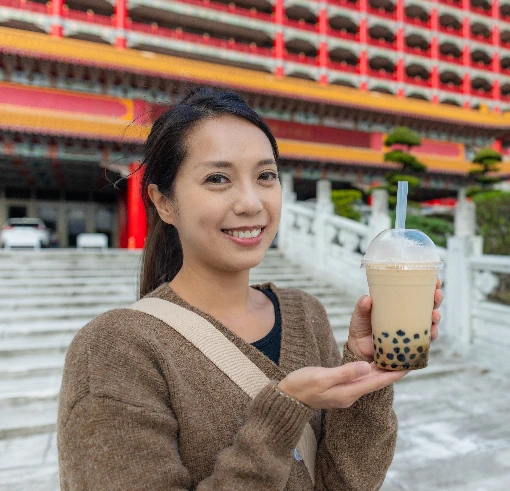
How do regional preferences influence bubble tea flavors?
When it comes to bubble tea, the world is your oyster—well, your tapioca pearl, to be precise. Regional preferences play a significant role in shaping the popularity and variety of these beloved drinks. There’s no one-size-fits-all here; flavours range from the traditional to the totally unconventional, influenced by geography, cultural leanings, and even urban or rural settings. So buckle up, bubble tea enthusiast. It’s time to sip our way around the globe.
Now, let’s break it down by looking at different regions and how they influence the scene. Asian nations have their distinct palate preferences, just as Western countries have their spin. Then there’s the tropical regions adding their fruity flair, and even urban versus rural communities imposing their subtle influences on what’s inside your cup.
What are the most popular flavors in Asia?
Asia is the birthplace of bubble tea, so let’s start there. It’s all about classic and authentic tastes, with a little bit of innovation thrown in for good measure.
- Original Milk Tea: The godfather of all bubble teas. Typically made with black tea, milk, and those chewy tapioca pearls.
- Matcha: Because, let’s face it, anything Japanese matcha touches turns into a trend.
- Taro: This purple-hued delight adds a starchy-sweet flavour that’s as Instagrammable as it is tasty.
- Honeydew: A cool, refreshing melon twist that’s popular in places like Taiwan and Hong Kong.
- Red Bean: Borrowed from traditional Asian desserts, red bean offers a slightly sweet, earthy taste that’s surprisingly delightful in tea form.
In Asia, traditional flavours reign supreme, but don’t be surprised if you find quirky local specialties making their way to the menu.
How do Western tastes influence bubble tea flavors?
It’s no secret that the West has a bit of a sweet tooth. When bubble tea landed on Western shores, it had to adapt—and adapt it did.
- Brown Sugar: Because why have regular tapioca pearls when you can have them bathed in brown sugar syrup?
- Chocolate: A universal love affair with chocolate can’t be ignored, even in bubble tea.
- Strawberry Cheesecake: Yes, bubble tea with actual cheesecake bits. Diet-friendly? Not so much. Delicious? Definitely.
- Salted Caramel: Perfecting the balance of sweet and salty, this flavour wins hearts across the dessert spectrum.
- Frozen Yogurt: Combining two popular trends—bubble tea and froyo—Western inventiveness at its finest.
Western tastes have expanded the bubble tea palette to include flavours that could double as dessert, thanks to an unabashed love for all things sweet and decadent.
How do tropical regions affect flavor choices?
In tropical areas, bubble tea takes on a whole new dimension. Think refreshing, fruity, and just what you need for a hot, sunny day.
- Mango: Fresh, juicy, and oh-so-tropical. Mango bubble tea is a crowd favourite.
- Passion Fruit: Tangy and refreshing, it’s a flavour that screams beach vibes.
- Coconut: Thanks to its creamy texture and natural sweetness, coconut makes for a delightful bubble tea base.
- Pineapple: A punch of tropical goodness that’s both tangy and sweet.
- Lychee: This floral fruit brings an exotic flair to your bubble tea experience.
Tropical regions bring their A-game with fruity options that are utterly refreshing and perfect for quenching a tropical thirst.
But let’s not forget the cultural nuances that add even more layers to this beverage. In urban areas, you might find fancier, Instagram-friendly drinks with unusual flavours like lavender or cheese foam. Meanwhile, rural regions might stick closer to traditional or locally-sourced ingredients.
During World War II, rationing led to some particularly interesting food innovations. In Taiwan, where bubble tea was born, people often had to get creative with limited supplies. This period indirectly influenced Taiwan’s culinary creativity, leading innovators decades later to experiment with humble ingredients like tapioca, which was historically a street food ingredient, and transform them into globally adored treats.
The humble beginnings and resourcefulness cultivated during tough times eventually found expression in the rich variety of bubble tea flavours we enjoy today. Cheers to innovation, one sip at a time.
What is the cultural significance of bubble tea?
Bubble tea is not just a drink; it’s a cultural icon. Born in Taiwan, this quirky concoction of tea, milk, sugar, and chewy tapioca pearls has transcended its humble beginnings to become a global sensation. It’s more than just a refreshment – it’s a social rite, a symbol of youthful indulgence, and a testament to the power of food (or in this case, drink) to connect people across cultures.
Here’s the lowdown: Taiwan introduced bubble tea to the world in the 1980s, and from there it’s taken on a life of its own, popping up everywhere from bustling city streets to quiet suburban cafes. It’s wormed its way into traditional tea ceremonies, and the younger crowd has latched onto it as their drink of choice.
Essentially, bubble tea is what happens when you take cultural heritage, mix it with a dash of modern flair, and serve it with a side of social connectivity.
How did bubble tea originate in Taiwan?
Let’s travel back to the 1980s in Taiwan, where two teashops claim the crown for inventing bubble tea: Chun Shui Tang in Taichung and the Hanlin Tea Room in Tainan.
The story begins with a whimsical blend of cold tea and sweet additives.
- Chun Shui Tang’s founder, Liu Han-Chieh, was inspired by iced coffee during a trip to Japan. He decided to experiment with iced tea, adding sugar and milk.
- An employee, Lin Hsiu Hui, added tapioca balls to her iced tea during a meeting, creating the first “pearl milk tea”.
- Hanlin Tea Room’s Tu Tsong-He similarly tinkered with white tapioca balls, inspired by fenyuan (traditional soft tapioca balls dessert).
Which tale carries the most truth? Only the bubble tea gods know. But one thing’s for sure: Taiwan brewed something magical that charmed taste buds worldwide.
Bubble tea isn’t just a drink. It’s an experience. Picture this: the thrill of choosing your tea base, the sweetness level, the toppings – it’s a Choose-Your-Own-Adventure book in liquid form.
Add in those Instagrammable, brightly coloured bubbles, and you’ve hit social-media gold.
- Personalisation: Choose the base, sweetness, toppings.
- Instagrammable: Vibrant colours, quirky presentations.
- Social activity: Great for hanging out, sharing a ‘boba run’.
- FOMO factor: New flavours and limited editions keep everyone coming back for more.
- Youthful vibe: Symbolises carefree indulgence and youth culture.
From high school students bonding over pearls to adults reliving their younger days, bubble tea weaves people into its social tapestry. Need an excuse to hang out? “Let’s go get boba!” does the trick.
How does bubble tea fit into traditional tea culture?
Tea culture and bubble tea. Traditional tea ceremonies focus on the elegance, preparation, and appreciation of tea. Bubble tea? It throws a tapioca party in your face. Yet, surprisingly, they manage to coexist.
- Fusion of the old and new: Traditional elements fused with new twists.
- Casual tea drinking: Appeals to a broader, often younger crowd.
- Endless variety: Keeps the concept of tea ever-evolving and relevant.
- Accessibility: Brings tea culture to the masses in an entertaining way.
- Gateway drink: Introduces people to different types of teas they might otherwise not try.
Bubble tea has carved out a niche where the sanctity of tea meets the fun of modern cravings, proving you can respect traditions and still have a blast coming up with new ones.
Bubble tea’s journey from the teahouses of Taiwan to global streets has echoes of another beverage story – that of Coca-Cola. Born in the USA in 1886, Coke transformed from a medicinal tonic to a universal symbol of refreshment, thanks to clever marketing and an uncanny knack for adapting to local tastes.
Much like bubble tea today, Coke threaded the needle between tradition and novelty. And just like Coca-Cola, bubble tea is more than a beverage; it’s a cultural ambassador, bridging gaps and bringing people together sip by sip.
So, next time you’re slurping down those pearls, remember – you’re part of a global tradition!
What are the healthiest bubble tea flavors?
Bubble tea isn’t just a sweet treat; it can also be a somewhat healthy beverage if you know what to pick. Consider these healthier bubble tea options: green tea, oolong tea, fruit-infused teas, low-sugar versions, and herbal teas. Now, let’s dive into what makes each of these options beneficial for you.
These tea choices not only cater to different taste buds but also offer distinct health perks. Plus, opting for low-sugar varieties ensures that you don’t get a sugar rush bigger than a kid on Christmas morning. Let’s break it down, shall we?
What makes green tea a healthy option?
Green tea is like the superhero of the tea world. It doesn’t wear a cape, but it’s packed with antioxidants and other health goodies.
- Antioxidants Galore: It’s loaded with catechins, which are natural antioxidants. These little guys help prevent cell damage.
- Boosts Metabolism: Helps in weight management by increasing fat-burning.
- Brain Function: Contains L-theanine, which can improve brain function and make you as sharp as a tack.
- Heart Health: Reduces bad cholesterol, keeping your ticker tocking along healthily.
- Cancer Fighter: Some studies suggest it helps in lowering the risk of certain types of cancer.
Move over, kale! Green tea is coming through. Incorporate it into your bubble tea for a refreshing and guilt-free sip.
How does oolong tea benefit health?
Oolong tea sits comfortably between green tea and black tea on the fermentation scale. It brings a bouquet of health benefits, too.
- Weight Loss: Speeds up your metabolism, aiding in weight loss.
- Heart Health: Lowers bad cholesterol and reduces the risk of heart disease.
- Dental Health: Contains fluoride which prevents tooth decay and strengthens your pearly whites.
- Digestive Aid: Helps with digestion, making post-meal bloat a thing of the past.
- Blood Sugar Control: Stabilizes blood sugar levels, super useful for folks with diabetes.
So, it’s not just a tasty treat. Oolong tea can elevate your bubble tea experience while making you feel better, too.
What are the benefits of low-sugar bubble tea options?
Low-sugar bubble tea isn’t just for those on a diet; it’s a smart choice for anyone who doesn’t want to bounce off the walls.
- Lower Blood Sugar: Reduces the risk of sugar spikes, which can make you feel crashy.
- Weight Management: Fewer calories mean you’ll fit into your jeans a bit longer.
- Flat Belly: Avoids the bloat that too much sugar can cause.
- Dental Health: Less sugar, fewer trips to the dentist – it’s that simple.
- Heart Health: Overloading on sugar is bad news for your heart, so why not keep it low?
Lowering the sugar doesn’t mean lowering the enjoyment. With a plethora of flavours at your disposal, you won’t even miss the extra sweetness.
In the 1980s, bubble tea didn’t exist. But across the world in Japan, green tea was already a cultural icon known for its health benefits. When Taiwanese tea shop owners created bubble tea, they drew upon these traditions, including the incorporation of green and oolong tea.
Imagine the first bubble tea cafe bustling with excitement, cork-like tapioca pearls hopping into curiosity-inducing concoctions. Today, we owe part of our favourite drink’s healthy potential to those early tea traditions. Just another reason to appreciate your bubble tea even more.
How can you make bubble tea at home?
So, you’ve been bitten by the bubble tea bug and now you’re itching to whip up some of that chewy, delightful goodness at home? Well, put your aprons on because we’re diving straight into the world of DIY bubble tea.
Prepare your taste buds for an adventure because, trust me, this is going to be better than any magic potion Harry Potter could conjure up.
What ingredients are essential for making bubble tea at home?
First things first, let’s talk ingredients. Get ready for a grocery list that might look a bit exotic but you’ll find most of it in your local Asian market or online.
- Tea: Black tea, green tea, oolong tea – you name it. Start with your favourite.
- Tapioca Pearls: The iconic chewy balls of joy also known as boba.
- Sweetener: Sugar, honey, or agave syrup. Pick your poison.
- Milk: For that creamy touch – whether you go for whole milk, almond milk, soy milk, or even oat milk.
- Flavouring: Fruit syrups, powders, or fresh fruit – there’s a whole universe here.
- Ice Cubes: To keep things refreshingly chilled.
Without these, you’re just sipping on sadness. Trust me, you don’t want to miss out on the crucial ingredients that make bubble tea what it is.
What equipment do you need to prepare bubble tea?
So, you’ve got the ingredients but are sweating over what fancy gizmos you need? Newsflash: no need for a spa-grade kitchen set-up. Here’s the lowdown:
- Pot: Any old pot for boiling the pearls.
- Strainer: A strainer to drain the pearls—duh.
- Shaker: Or just a mason jar with a tight lid will do the trick.
- Stirrer: A spoon or a handy whisk.
- Large Straw: Unless you fancy slurping tapioca pearls like a kid trying to sip jelly.
With this arsenal, you’ll be ready to take on the bubble tea brewing challenge like a true master. Minimal faff, maximal flavour.
How can you customise bubble tea to your taste?
Now for the fun part—customisation! It’s like Minecraft but for your taste buds. Here’s how you can jazz up your bubble tea:
- Sweetness Level: Adjust the sugar or syrup to your personal likings, from “I’ll have diabetes for lunch” to “I’m watching my waistline”.
- Tea Strength: Steep your tea longer for a stronger punch or go light for a mellow charm.
- Flavours: Experiment with different syrups, matcha powder, or even cocoa to create unique blends.
- Toppings: Beyond tapioca, think grass jelly, aloe vera cubes, or popping boba.
- Milk: Swap regular milk with coconut, almond, or even a dash of condensed milk for various textures and tastes.
With so many ways to tweak your brew, your bubble tea can easily star in its own reality TV show: “Keeping Up with Bubble Tea”.
Let’s not forget—a bit of history always adds some zest. Did you know bubble tea was ‘accidentally’ invented in Taiwan in the 1980s? Legend has it that a tea house owner spontaneously poured tapioca balls into iced tea during a meeting, and a sensation was born. Taiwan’s Chun Shui Tang tea house now claims credit, with Liu Han Chieh at the helm of this genius move. Fun fact: you can still visit the original store in Taichung, Taiwan.
Now that you know how to make bubble tea at home, go forth and concoct your dreamy blend of magic!
Where can you find the best bubble tea in your area?
Looking for the holy grail of bubble tea? You’re not alone. Finding the best bubble tea shop is a quest many embark on. You might be scrolling through reviews, asking your foodie friends, or simply wandering the streets sniffing out that sweet, milky aroma.
Let’s break down how to navigate this landscape of tapioca-filled goodness.
First, you’ve got your trusty online reviews and recommendations. Websites and apps like Yelp, TripAdvisor, and Google Reviews are your new best friends. Feedback from fellow bubble tea enthusiasts helps ensure you’re not wasting your hard-earned cash on a mediocre drink. Then there are local recommendations and word-of-mouth tips.
These usually come from those who’ve tried every shop in town and aren’t shy about sharing their favourites. Popular chains like Gong Cha and Chatime can be reliable options, but sometimes the hidden gems in your city steal the show. Apps dedicated to finding bubble tea can also guide you to the nearest boba haven.
How can online reviews help you find good bubble tea?
Online reviews are the modern-day equivalent of scouting missions. They can save you from brewing disasters and direct you to boba bliss.
- Honest opinions: People online rarely mince words. If the tapioca pearls are as hard as marbles, they’ll tell you.
- Photos galore: See what you’re getting into. Pictures can show you if the tea is just right or if it’s a hot mess.
- Star ratings: A quick glance at ratings can tell you if a place is a hit or miss.
- Menu insights: Reviews often include detailed descriptions of flavours and options available.
- Location tips: The best bubble tea shops are often tucked away in corners you wouldn’t expect.
Reading reviews can save time and money, making sure you spend both wisely. Plus, they can give you the lowdown on the must-try items on the menu.
What are some popular bubble tea chains to try?
If you’re not the adventurous type or you’re just looking for consistency, hitting up popular chains might be the way to go. These chains have built their reputations on delicious, dependable drinks.
- Gong Cha: Known for its authentic taste and extensive menu.
- Chatime: Offers a variety of interesting flavours and additives.
- Coco Fresh Tea & Juice: Made a name for itself with fresh ingredients.
- Koi The: Famous for its golden bubble and unique tea blends.
- Sharetea: Renowned for rich and creamy milk teas.
These chains have locations worldwide, and their popularity speaks volumes about their quality and customer satisfaction.
How can you discover unique local bubble tea shops?
Sometimes, the unique local bubble tea shops are where the magic really happens. They often offer one-of-a-kind experiences you won’t get from a chain.
- Explore neighbourhoods: Walk around different parts of town to find hidden treasures.
- Social media: Follow local foodie influencers or browse hashtags like #BubbleTeaCityName.
- Festivals and events: Local food festivals often feature indie bubble tea shops.
- Ask locals: Who knows better than the people living there? Strike up a conversation with someone at a local café.
- Apps: Use apps like Boba Bliss or Boba Finder, which specialise in finding local bubble tea spots.
These lesser-known gems often bring innovation and creativity to their offerings, making them worth the hunt.
Conclusion
Reflecting on the vibrant world of bubble tea, it’s clear that this beloved beverage is more than just a drink—it’s a cultural phenomenon that continues to evolve and captivate enthusiasts across the globe. Throughout our exploration, we examined the classic flavours like milk tea and taro, which have long endured the test of time due to their rich flavours and comforting qualities. We also uncovered a delightful array of fruit-based flavours, each with its own unique blend of ingredients that cater to regional preferences, highlighting the diverse palates around the world.
As we ventured into the realm of innovative tastes like yogurt tea and cheese tea, it became evident that bubble tea is not just about tradition; it’s also about pushing boundaries and experimenting. This influence also extends regionally, shaping how bubble tea is enjoyed in various cultures, from the streets of Taiwan to cafes in urban Western settings. The discussion on health-conscious options likewise serves to remind us that one can indulge without compromising well-being.
With this understanding, I am inspired to encourage fellow bubble tea aficionados to explore these flavours and perhaps even try their hand at crafting their own at home. The recipes and techniques shared throughout this article can open new avenues for creativity and personal taste in our beloved bubble tea.
In this colourful tapestry of flavours and cultural significance, I invite you to ponder: What does your favourite bubble tea flavour say about you? As you sip your next cup, consider the stories behind each bubble, each ingredient, and the global journey that brought it to your hands. Artisan or chain, classic or innovative—there’s a whole world of discovery waiting to be unwrapped, one sip at a time.
Resources
- Health Concern of Phenomenally Premium Boba Milk Tea and Pearls Beverages in Kuala Lumpur: Sugary Content and Physico-chemical Profiles Analysis
- Calories and Sugars in Boba Milk Tea: Implications for Obesity Risk in Asian Pacific Islanders
- Effects of Chronic Bubble Tea Administration on Behavior and Cognitive Function in Mice
- Calories and Sugars in Boba Milk Tea: Implications for Obesity Risk in Asian Pacific Islanders
- What Makes Bubble Tea Popular ? Interaction between Chinese and British Tea Culture
- Consumer Preference Analysis on Attributes of Milk Tea: A Conjoint Analysis Approach
- Examining the Factors that Influence Consumer Willingness to Pay of Bubble Tea among Generation Z in Bandung, Indonesia
- Global research trends on herbal tea: A bibliometric and visualized analysis


